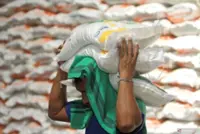
Never again: (Clockwise from top left) Taeko Oshioka, a member of Nihon Hidankyo, looking for visitors to sign a petition urging the Japanese government to sign and ratify the treaty of the prohibition of nuclear weapons, in front of the preserved Atomic Bomb Dome; demonstrators attending a protest in support of Palestinians in Gaza, echoing Nihon Hidankyo’s anti-nuclear armaments message; members of Nihon Hidankyo and atomic bomb survivors posing together for a press conference; paper cranes, known as a symbol of peace, seen at the office of Nihon Hidankyo after they won the 2024 Nobel Peace Prize; and a visitor praying in front of the Peace Statue at the Peace Park in Nagasaki. — Reuters/AFP/AP
The recipient of this year’s Nobel Peace Prize is a fast-dwindling group of atomic bomb survivors who are facing down the shrinking time they have left to convey the firsthand horror they witnessed 79 years ago.
Nihon Hidankyo, the Japanese organisation of survivors of the US atomic bombings on Hiroshima and Nagasaki, was awarded for its decades-long activism against nuclear weapons. The survivors, known as “hibakusha”, see the prize and the international attention as their last chance to get their message out to younger generations.
“We must seriously think about the succession of our messages. We must thoroughly hand over from our generation to the future generations,” Toshiyuki Mimaki, senior member of the Hiroshima branch of Hidankyo, said on Friday night.
“With the honour of the Nobel Peace Prize, we now have a responsibility to get our messages handed down not only in Japan but also across the world.”
The honour rewards members’ grassroots efforts to keep telling their stories – even though that involved recollecting horrendous ordeals during and after the bombings, and facing discrimination and worries about their health from the lasting radiation impact – for the sole purpose of never again let that happen.
Now, with their average age at 85.6, the hibakusha are increasingly frustrated that their fear of a growing nuclear threat and push to eliminate nuclear weapons are not fully understood by younger generations.
The number of prefectural hibakusha groups decreased from 47 to 36. And the Japanese government, under the US nuclear umbrella for protection, has refused to sign the Treaty on the Prohibition of Nuclear Weapon.
But there is hope, and a youth movement seems to be starting, the Nobel committee noted.
Three high school students accompanied Mimaki at the city hall, stood by him as the prize winner was announced, and promised to keep their activism alive.
“I had goose bumps when I heard the announcement,” said a beaming Wakana Tsukuda. “I have felt discouraged by negative views about nuclear disarmament, but the Nobel Peace Prize made me renew my commitment to work toward abolishing nuclear weapons.”
Another high school student, Natsuki Kai, said, “I will keep up my effort so we can believe that nuclear disarmament is not a dream but a reality.”
In Nagasaki, another group of students celebrated Hidankyo’s win. Yuka Ohara, 17, thanked the survivors’ years-long effort despite the difficulty.
Ohara said she heard her grandparents, who survived the Nagasaki bombing, repeatedly tell her the importance of peace in daily life. “I want to learn more as I continue my activism.”
In April, a group of people set up a network, Japan Campaign to Abolish Nuclear Weapons, connecting younger generations around the country to work with survivors and pursue their effort.
Efforts to document the survivors’ stories and voices have grown in recent years around Japan, including in Hiroshima, Nagasaki and Tokyo. In some places, young volunteers are working with hibakusha to succeed their personal story telling when they are gone.
The first US atomic bombing killed 140,000 people in the city of Hiroshima. A second atomic attack on Nagasaki on Aug 9, 1945, killed another 70,000. Japan surrendered on Aug. 15, bringing an end to its nearly half-century aggression in Asia.
Hidankyo was formed 11 years later in 1956. There was a growing anti-nuclear movement in Japan in response to US hydrogen bomb tests in the Pacific that led to a series of radiation exposures by Japanese boats, adding to demands for government support for health problems.
As of March, 106,823 survivors – 6,824 fewer than a year ago, and nearly one-quarter of the total in the 1980s - were certified as eligible for government medical support, according to the Health and Welfare Ministry. Many others, including those who say they were victims of the radioactive “black rain” that fell outside the initially designated areas of Hiroshima and Nagasaki, are still without support. — AP






































